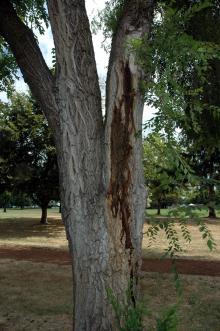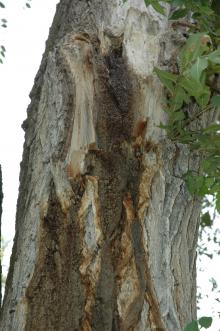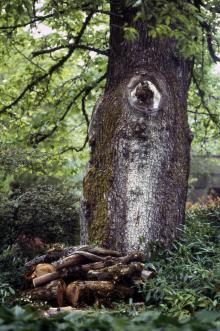Cause Wetwood is associated with bacteria including Enterobacter nimipressuralis, Bacillus megaterium, and Pseudomonas sp. Liquid accumulates in diseased tissue of the tree which is then colonized by the bacteria. Anaerobic growth of the bacteria produces gas inside the tree. The high gas pressure forces liquid out of the tree where it dries on the bark. A higher pH also can be detected in diseased tissue. Wetwood has been observed in elm, willow, and locust especially in eastern and southern Oregon.
Symptoms Wetwood can be in all parts of the tree but is not obvious in xylem tissue less than 10 years old. Trunks show a circular dark brown discoloration of the wood in cross-section. When freshly cut, wood appears water soaked. In large limbs, the central core is discolored. Wilting twigs and branches show discoloration out to the sapwood.
Wetwood also is associated with wounds. Liquid forced out by internal pressure exits near wounds or high-angled branch crotches and drips down the trunk. This liquid is at first colorless to light yellow but turns brown when exposed to air. Light gray to white streaks stain the outside bark below these areas.
Cultural control No controls are known to avoid initiation or development of wetwood. Installing metal or plastic drain tubes to release pressure and drain excess liquid away is not recommended. The tubes are thought to help spread wetwood to uninfected areas, bypassing the tree's normal defense mechanisms. Draining the fluid also is thought to increase the likelihood of fungal decay.
Chemical control
- Arbor-OTC is registered for trunk injection, see label for details. Group 41 fungicide (antibiotic). 12-hr reentry.
References Shigo, A.L. 1986. A New Tree Biology. Durham, NH: Shigo and Trees, Associates.
Stipes, R.J. and R.J. Campana. 1981. Compendium of Elm Diseases. St. Paul, MN: APS Press.



